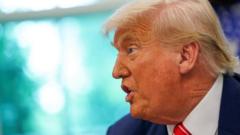In a noteworthy move reminiscent of his first term, US President Donald Trump has unveiled a new travel ban affecting individuals from 12 countries. This new policy revisits a hallmark from his presidency but is designed with significant legal improvements from past experiences.
The initial travel ban sparked widespread protests in 2017 and faced numerous legal challenges due to its controversial targeting of predominantly Muslim nations. Critics labeled it the "Muslim ban," and arguments emerged suggesting it was unconstitutional, as it discriminated against travelers on religious grounds. The original ban underwent amendments to navigate judicial obstacles, ultimately resulting in a Supreme Court-upheld version in 2018.
Experts, including Christi Jackson from Laura Devine Immigration, contend that Trump has learned from the failures of his first attempt, making this new ban more structurally sound. Jackson notes that the latest restrictions are "wider in scope" with "clearly defined" exemptions, addressing the ambiguity that plagued past policies. Moreover, while similarities remain in some of the targeted nations, the new ban does not explicitly focus on Muslim-majority states.
Barbara McQuade, a law professor at the University of Michigan, expressed confidence that this time the ban might withstand Supreme Court scrutiny if challenged, due to its refined framework. The travel restrictions, effective from June 9, primarily affect countries in the Middle East, Africa, and parts of the Caribbean, including Afghanistan, Iran, and Somalia, with partial restrictions also imposed on nations like Cuba and Venezuela.
In announcing this controversial policy via a video on X, Trump cited a recent incident involving an Egyptian national accused of violence during a demonstration as justification for the heightened restrictions. However, notably, Egypt has not been included on either the full ban or partial restriction lists.
Despite Trump's claims linking the legislation to national security concerns and high visa overstay rates, some critics point out that the benchmarks used for these criteria remain unclear, potentially opening the door for legal challenges. Immigration attorney Steven D Heller highlighted the ambiguity surrounding the overstay justification, questioning the threshold necessary to qualify a country for the ban.
In a stark departure from the first ban, which was initially set to expire in 90 to 120 days, the new order carries no specified end date, leaving it open-ended. Countries identified in the ban have voiced strong opposition, with Venezuelan officials denouncing the Trump administration, while others like Somalia aim to initiate discussions to address the concerns raised by the policy.
The original travel ban prompted significant demonstrations and turmoil at U.S. airports, and its repeal was one of the first actions taken by President Joe Biden in 2021, who condemned it as “a stain on our national conscience.”
The initial travel ban sparked widespread protests in 2017 and faced numerous legal challenges due to its controversial targeting of predominantly Muslim nations. Critics labeled it the "Muslim ban," and arguments emerged suggesting it was unconstitutional, as it discriminated against travelers on religious grounds. The original ban underwent amendments to navigate judicial obstacles, ultimately resulting in a Supreme Court-upheld version in 2018.
Experts, including Christi Jackson from Laura Devine Immigration, contend that Trump has learned from the failures of his first attempt, making this new ban more structurally sound. Jackson notes that the latest restrictions are "wider in scope" with "clearly defined" exemptions, addressing the ambiguity that plagued past policies. Moreover, while similarities remain in some of the targeted nations, the new ban does not explicitly focus on Muslim-majority states.
Barbara McQuade, a law professor at the University of Michigan, expressed confidence that this time the ban might withstand Supreme Court scrutiny if challenged, due to its refined framework. The travel restrictions, effective from June 9, primarily affect countries in the Middle East, Africa, and parts of the Caribbean, including Afghanistan, Iran, and Somalia, with partial restrictions also imposed on nations like Cuba and Venezuela.
In announcing this controversial policy via a video on X, Trump cited a recent incident involving an Egyptian national accused of violence during a demonstration as justification for the heightened restrictions. However, notably, Egypt has not been included on either the full ban or partial restriction lists.
Despite Trump's claims linking the legislation to national security concerns and high visa overstay rates, some critics point out that the benchmarks used for these criteria remain unclear, potentially opening the door for legal challenges. Immigration attorney Steven D Heller highlighted the ambiguity surrounding the overstay justification, questioning the threshold necessary to qualify a country for the ban.
In a stark departure from the first ban, which was initially set to expire in 90 to 120 days, the new order carries no specified end date, leaving it open-ended. Countries identified in the ban have voiced strong opposition, with Venezuelan officials denouncing the Trump administration, while others like Somalia aim to initiate discussions to address the concerns raised by the policy.
The original travel ban prompted significant demonstrations and turmoil at U.S. airports, and its repeal was one of the first actions taken by President Joe Biden in 2021, who condemned it as “a stain on our national conscience.”




















